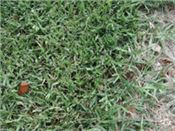|
Cool Overnight Temperatures Slowing Bermudagrass Growth

Love it or hate it, bermudagrass is one tough lawn grass.
Image courtesy of Gerald Klingaman
LITTLE ROCK, ARK.
As the spring of 2017 continues to take its toll on various crops, primarily in the eastern portion of the state, cool nighttime temperatures in the northern portion of Arkansas have additionally slowed the growth of bermudagrass, a grazing forage grass for many cattle operations.
John Jennings, extension forage specialist and professor for the University of Arkansas System Division of Agriculture, said the warm winter fueled expectations of an early spring and quick forage growth.
“The 15-day forecast for late May shows warming night temperatures in the 60+ degree range for central and south Arkansas,” Jennings said, “but night temperatures for the higher elevations in north Arkansas are still forecast to be in the 50’s, with a few nights forecast to be in the upper 40’s.”
Bermudagrass is a warm season grass that needs warm temperatures both day and night to truly thrive, Jennings said.
“It begins greening up after warm days, but never really produces significant growth until night temperatures are 60 degrees for about a week or more,” he said. “The grass will try to grow on warm days, but cool night shuts down the internal ‘machinery,’ which basically negates any sustained growth.”
When a string of warm nights occurs, the grass is ready to begin sustained growth as spring temperatures continue to warm till summer. Fertilizing bermudagrass before night temperatures have reached the 60 degree mark results in lower fertilizer efficiency, Jennings said.
When performing below optimum efficiency, other cool season grasses or weeds will often out-compete the languishing bermudagrass for the available nutrients in the soil. Jennings said that for mixed pastures with fescue and bermudagrass, the fescue will likely continue to grow through this cool weather, with bermuda finally catching up as summer temperatures arrive.
Growers should determine fertilizer recommendations through soil testing, especially for hay production.
“Pasture fertilizer recommendations are generally much lower than for hay due to recycling of nutrients,” Jennings said. “In recent years, many hay producers have neglected to apply sufficient potassium fertilizer for hay production, and bermudagrass stands have thinned significantly as a result.”
Bermudagrass hay fertilization recommendations from the Division of Agriculture are designated by production level, so requesting recommendations for the desired production level at the time of soil sample submission will help growers get the optimum recommendations.
“For most producers, hay yield levels of either 2 or 4 tons per acre are sufficient for the soil and environment,” Jennings said. “In most cases, yield levels of 6 tons per acre would be on the high end for dryland hay production, and yield levels of 8 tons per acre are usually under irrigation or exceptional growing conditions.”
Soil test results from the Division of Agriculture include notes within the report providing recommendations on how to split the total fertilizer recommendation for season-long production. ∆
|
|